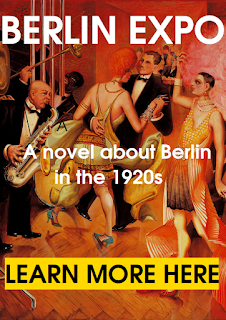Tell
me what you read and I'll tell you who you are, someone said. In the
Weimar Republic, if you knew what newspaper a person read, you could
be pretty sure of his political opinions.
If she read Die Rote Fahne for example, she was most likely a member or at least a supporter of the Communist Party KPD. But if he read Der Angriff, you could put your money on he being close to the Nazis – and win your bet. Because the German newspapers had, for the most part, a long tradition of adherence to a political cause.
Which newspaper read for example Bertolt Brecht? BZ am Mittag I would say. It was after all what everyone read, except the right-wing people, who preferred the Nachtausgabe. But our good Bert's favorite was surely Welt am Abend by Willi Münzenberg (a great journalist whom Brecht knew personally), a dynamic and irreverent tabloid, in line with the Communist Party KPD, but much funnier than Die Rote Fahne, the official party newspaper. The Fahne was read only by activists, its sales numbers were only one-tenth of Welt am Abend.
And Christopher Isherwood, what did he read? An English writer exiled to Berlin? To build himself an opinion of the situation in Germany, I suppose he didn’t limit himself to the left-wing newspapers such as the social-democrat Vorwärts or the Berliner Morgenpost, left-liberal, but he glanced also at Herr Hugenberg's Lokal-Anzeiger, and, if only to read the cultural pages, at the Börsen-Courier (in the morning, because the evening edition of the Courier was devoted, as the name of the newspaper suggests, to the stock market movements). I doubt he that he read the Vossische Zeitung; if he had left England for Berlin it was precisely for a change of air, and "Aunt Voss" (as the very serious newspaper was familiarly called) was the equivalent of The Times.
If she read Die Rote Fahne for example, she was most likely a member or at least a supporter of the Communist Party KPD. But if he read Der Angriff, you could put your money on he being close to the Nazis – and win your bet. Because the German newspapers had, for the most part, a long tradition of adherence to a political cause.
Which newspaper read for example Bertolt Brecht? BZ am Mittag I would say. It was after all what everyone read, except the right-wing people, who preferred the Nachtausgabe. But our good Bert's favorite was surely Welt am Abend by Willi Münzenberg (a great journalist whom Brecht knew personally), a dynamic and irreverent tabloid, in line with the Communist Party KPD, but much funnier than Die Rote Fahne, the official party newspaper. The Fahne was read only by activists, its sales numbers were only one-tenth of Welt am Abend.
And Christopher Isherwood, what did he read? An English writer exiled to Berlin? To build himself an opinion of the situation in Germany, I suppose he didn’t limit himself to the left-wing newspapers such as the social-democrat Vorwärts or the Berliner Morgenpost, left-liberal, but he glanced also at Herr Hugenberg's Lokal-Anzeiger, and, if only to read the cultural pages, at the Börsen-Courier (in the morning, because the evening edition of the Courier was devoted, as the name of the newspaper suggests, to the stock market movements). I doubt he that he read the Vossische Zeitung; if he had left England for Berlin it was precisely for a change of air, and "Aunt Voss" (as the very serious newspaper was familiarly called) was the equivalent of The Times.
But
Lothar, the brother of Otto Nowak, a character from Farewell to
Berlin, Isherwood's novel, surely read Der Angriff, Goebbels'
tabloid. Lothar was a young worker who was struggling to find a job
in a time of high unemployment.
Harry Shadow, the character of the novel Berlin Expo, was another one who certainly read the Courier, if only for Herbert Ihering's theatrical criticism, with which he was almost always in disagreement, but Harry liked the contradiction. Ihering (who liked Brecht's theater) often argued with Alfred Kerr, another critic who wrote in the Berliner Tageblatt and didn’t appreciate Brecht at all.
Harry Shadow, the character of the novel Berlin Expo, was another one who certainly read the Courier, if only for Herbert Ihering's theatrical criticism, with which he was almost always in disagreement, but Harry liked the contradiction. Ihering (who liked Brecht's theater) often argued with Alfred Kerr, another critic who wrote in the Berliner Tageblatt and didn’t appreciate Brecht at all.
Harry, a leftist, a revolutionary, of course did not read Der Angriff. As for Tempo, the tabloid that served as a model for Angriff, Harry refers to him only by the term "junk". He does not, however, use the term "Jewish press" dear to Goebbels. His girlfriend, Violetta, chose newspapers according to her mood. As for Tempo, she found it very amusing, which annoyed Harry.
And Erwin Keller, the art dealer of the same novel? His colleague Morel, another character in L’exposition, thinks Keller is voting for the liberal-center-left DDP. If Morel is right, then Keller is a faithful reader of the Morgenpost or the Tageblatt.
Today’s newspapers appear either in the morning or in the evening. But Berlin newspapers usually appeared two or even three times a day, with updated editions. Each additional edition cost relatively little, the costs remaining constant for the publishing house.
There is much more to say about Berlin newspapers during the Weimar Republic and I intend to do so in the next posts of this blog.
 |

No comments:
Post a Comment